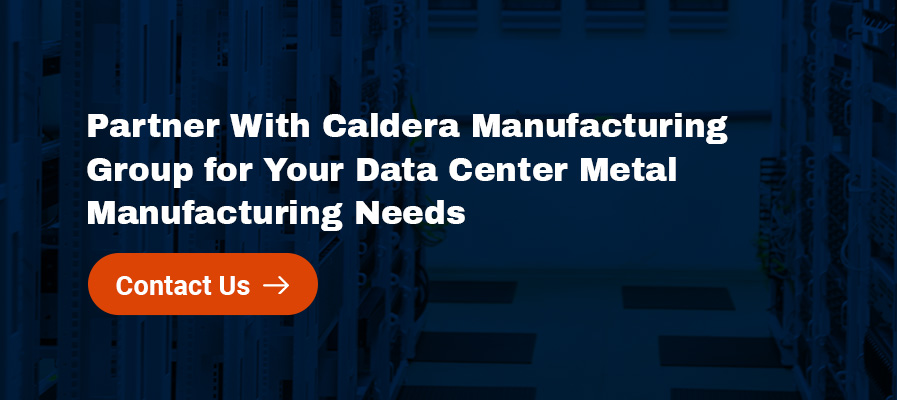Data centers are critical to many modern businesses’ daily operations. The manufacturers who develop the organizational components and physical devices used in data centers have an important responsibility to ensure reliability and efficiency.
Metal fabrication is a cornerstone of manufacturing various elements needed for data centers, including cooling systems and server racks. The metal components’ durability, strength and precision ensure the peak performance of your facility.
Below, we dive into the relationship between manufacturing and data centers.
The physical infrastructure of data centers forms the foundation of all the other components, like computing, networking and storage resources. It typically consists of elements that house, power, cool and connect different technologies while ensuring servers and storage devices operate effectively and efficiently.
The following elements comprise the physical infrastructure of data centers:
Metal manufacturing is necessary to organize the racks and enclosures that facilitate the vertical stacking and securing of networking devices, servers, storage systems and other gear. The racks use metal components such as galvanized or stainless steel to facilitate cooling efficiency, while aluminum forms good housing for power distribution units.
Stainless steel cable trays make efficient cable management systems that support heavy loads at data centers. Metal is also used to construct structural supports, frames and means that stabilize data center solutions. It is the best material for numerous applications because it withstands harsh environments and improves heat dissipation.
Constructing data centers is a process that requires production efficiency and flexibility. It involves integrating emerging manufacturing technologies to streamline data center operations and management.
The metal manufacturing process for data centers typically involves the following.
Precision sheet metal fabrication involves cutting, bending and assembling flat aluminum or stainless steel sheets to create server racks, enclosures and cabinets. Aluminum and stainless steel are the best materials for precision fabrication because of their strength, formability and corrosion resistance.
The process requires accuracy and keen attention to detail to guarantee high-quality, durable and secure equipment that withstands the demands of growing data centers. The precision and accuracy of sheet metal fabrication ensure optimal airflow management and adherence to industry standards and compliance.
Customizing data center infrastructure is also essential to address your specific IT performance needs while satisfying the necessary safety criteria.
The growing demand for digital services has significantly increased the power requirements of many businesses. In data centers, cooling costs make up at least 40% of total energy consumption.
Therefore, the best way to reduce energy utilization at a data center is by implementing more efficient temperature control practices. Heat dissipation ensures efficient performance and minimizes damage to the resources. Precision sheet metal fabrication improves airflow design, reducing the risk of overheating and improving the cooling system’s efficiency.
While conventional HVAC systems can remove some of the heat from IT infrastructure, specialized cooling technologies are required to combat potential overheating. Adequate rack arrangements and cooling units improve airflow and efficiency.
Free, evaporative, air and liquid cooling are sustainable and environmentally friendly climate-control technologies to maximize energy efficiency for data centers. The right choice for your facility depends on its size, location and specific infrastructure needs.
As businesses grow, they continue to deal with increasing amounts of data, requiring your data centers to be flexible and scalable. Implementing a scalable data center infrastructure ensures you can meet all your current needs and future-proof your growth.
A strategic approach to data and equipment management is key for your company to maintain data availability and security requirements, enabling your team to effectively handle rising data volumes and more servers without lags and bottlenecks. Scalable networks optimize the use of storage systems and minimize waste and redundancy, ensuring efficient asset management. They also improve user traffic management and load balancing to eliminate downtime and response delays.
Several technologies are revolutionizing the manufacturing of data centers. These solutions can boost your facility’s flexibility and efficiency by enhancing equipment quality and design.
Some of the leading technologies steering the manufacturing for data centers include:

Your company needs a reliable metal manufacturing company to handle the design and construction of your data center. Robust physical infrastructure supports critical components, like cooling systems and server racks, that improve data center efficiency.
At Caldera Manufacturing Group, we offer customizable data center infrastructure that meets specific client and project needs. We help you optimize your facility’s available space and ensure scalability, leaving ample room for future technological upgrades and expansions. We also use environmentally friendly fabrication practices to reduce your carbon footprint.
Our operations all take place in the United States, allowing us to offer competitive prices and meet your quality expectations. Contact us today to discuss the needs of your data center infrastructure.